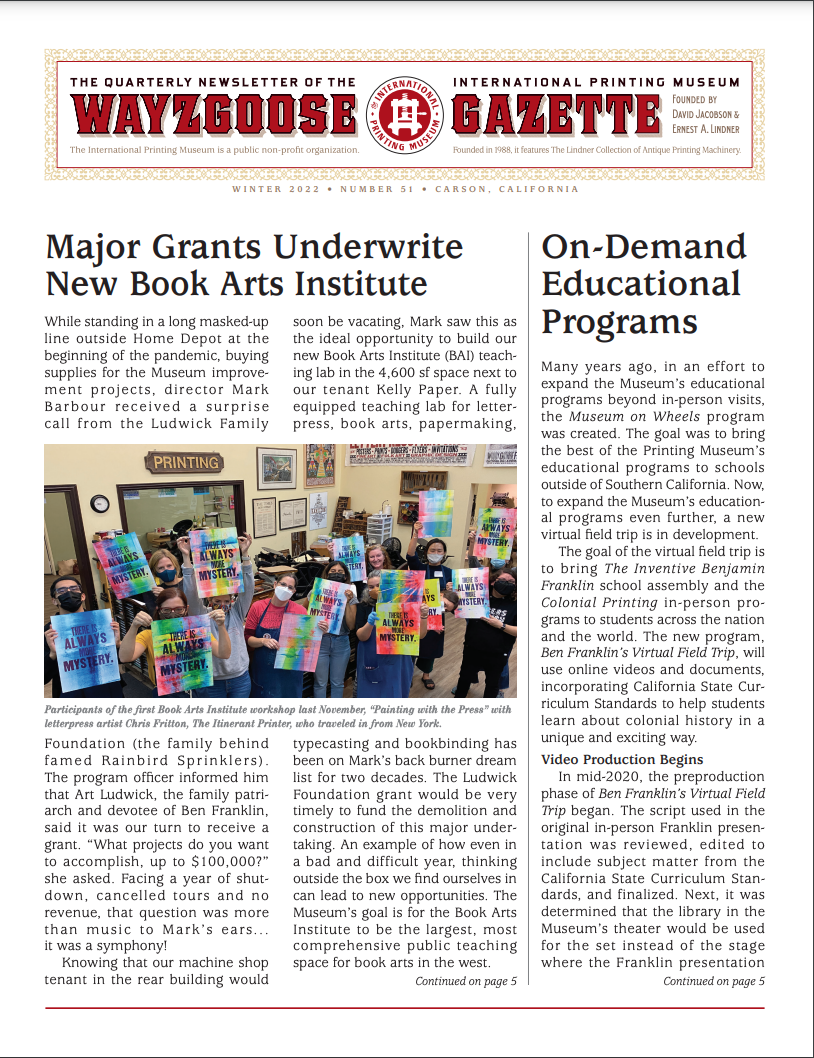PRINTERS AND PANDEMICS: PART II
/Outbreaks, endemics, and pandemics were regular occurrences in America during the 18th century. And the printing industry served to announce, educate, and debate the best ways for the average citizen to survive these occurrences. Evidence of such can be seen in the broadside above.
The earliest American engraver and the first Boston printer, John Foster, printed the Brief Rule pictured above. He was born in South Boston. After graduating from Harvard College in 1667, he became a teacher in Dorchester. In addition to teaching, Foster also taught himself printing and by 1675, left teaching to open a print shop in Boston. The broadside pictured was printed in 1677 during one of six smallpox epidemics in Boston from 1636 to 1698.
The Revolutionary War and Disease
Smallpox and measles were just a few of the viral infections colonial Americans faced. During the Revolutionary War, George Washington and his Continental Army suffered a threat that proved deadlier than the British, a smallpox epidemic, lasting from 1775-1782.
Fortunately for the Americans, General Washington had some personal experience with smallpox. In 1751, while visiting the Caribbean island of Barbados, Washington wrote that he “was strongly attacked by the small Pox.” Due to his experience, Washington knew that smallpox spread only from person to person. He also knew it could take up to fourteen days before a person exposed to it would show symptoms. Thus, people had to be quarantined for up to two weeks, and quarantined soldiers made it hard for a general trying to fight a war. In addition to his personal experience with smallpox, Washington was also familiar with a medical procedure recently introduced to the colonies.
The Advancement of Science
For centuries it was understood that some diseases never re-infect a person after recovery. As far back as 200 BC, the Chinese experimented with “variolation” or inoculation to fight disease. The procedure was commonly carried out by rubbing powdered smallpox scabs into superficial scratches made in the skin. The patient would develop sores identical to those caused by naturally occurring smallpox, but this usually produced a less severe disease than that acquired naturally. The patient would then be isolated for two to four weeks. By the end of the quarantine, the symptoms would subside, indicating successful recovery and immunity. This knowledge of variolation traveled through Asia into the Middle East and to Africa.
In 1706, Puritan minister Cotton Mather heard from Onesimus, his enslaved West African servant, “that he had undergone an operation, which had given him something of ye Small-Pox, and would forever preserve him from it.” He had described the process of variolation.
In 1721, when the residents of Boston once again began to fall ill with smallpox, Mather circulated information about variolation to the Boston medical community by pamphlet. Within days of reading the booklet, Zabdiel Boylston, a Boston physician, inoculated his son and two servants. William Douglass, a physician, trained in Europe, strongly opposed inoculation because it had not been tested or proven to be a safe procedure.
By 1722, variolation had become a flashpoint among the colonists. Just like today with the anti-vaccination movement, there were those in the 18th century who fought against inoculation. The inoculation controversy played out publicly through pamphlets and newspapers such as the Boston Gazette and The New England Courant.
The main arguments against variolation were on religious grounds. Some believed it was a direct affront to God’s innate right to determine who was to die, and how and when death would occur. Others thought smallpox outbreaks were punishments for the sins of those who contracted the disease.
The Courant, at the time, was under the leadership of 16-year-old Benjamin Franklin. The newspaper published satirical articles about Mathers and inoculation in the months following the epidemic. Despite the controversy, Mather and Boylston continued with the process during the Boston smallpox outbreak.
On February 22, 1722, it was officially announced that no new cases of smallpox appeared in Boston. The final figures from the outbreak supported the use of inoculation. Boylston’s 247 inoculated patients had a 2% death rate versus the 15% of people who died if they got smallpox naturally. After the outbreak, Boylston went to London, where similar experiments were taking place. By 1726, he published a very carefully documented book, An Historical Account of the Smallpox Inoculated in New England. It was the first systematic clinical presentation by an American physician.
Even with mounting evidence of the benefits of inoculation, many colonialists were still uncomfortable with the idea. The practice was banned in many colonies. Even Benjamin Franklin continued to oppose inoculation, but that would soon change. In 1736, Franklin’s four-year-old son, Francis Folger Franklin, died of smallpox. In his autobiography, Franklin said, “In 1736 I lost one of my sons, a fine boy of four years old, by the smallpox taken in the common way. I long regretted bitterly and still regret that I had not given it to him by inoculation. This I mention for the sake of the parents who omit that operation, on the supposition that they should never forgive themselves if a child died under it; my example showing that the regret may be the same either way, and that, therefore, the safer should be chosen.”
After his son’s death, Franklin began to study Epidemiology, “that which comes upon the people.” Franklin researched smallpox cases in Boston. He compared the number of deaths attributable to smallpox “in the common way,” and people who received variolation.
Based on his research, Franklin promoted variolation in his 1750 Poor Richard’s Almanack. He also argued against one of the main arguments that variolation was immoral because it interfered with God’s will. Franklin said it was “impious to reject a Method discovered to Mankind by God’s good Providence, whereby 99 in 100 are saved,” compared with the “natural” mortality of one in seven.” Franklin’s belief in the power of variolation moved him to recruit the distinguished British physician, William Heberden, to write a pamphlet describing smallpox inoculation and its consequences.
According to Franklin, “In 1758, I encouraged my friend Dr. William Heberden, F.R.S., to prepare a pamphlet that might provide to many the means and encouragement they required to inoculate their children. This was done by that good man, and the results, Some Account of the Success of Inoculation for the Smallpox in England and America, was published on February 16, 1759. I wrote the preface for this pamphlet.”
In addition to writing the multi-page preface, Franklin sent 1,500 free pamphlets to Philadelphia to persuade impoverished parents to variolate their children. In 1774, he raised money for free inoculation of the indigent.
The Application of Science
Luckily for the colonists and the Revolutionary Army, General Washington embraced the science-based medical treatments promoted by Franklin. This was not a popular stand, though, especially in Washington’s home state of Virginia, where variolation was illegal. Also, the Continental Congress ordered Army surgeons not to perform variolations.
Washington, however, was a firm believer in science-based medical treatments. He even went so far as to persuade his wife, Martha, to undergo the procedure in May 1776.
As a believer, Washington was in a tough situation. Even if he ordered the troops to be inoculated, he’d have to wait for them to complete quarantine of fourteen days before they could fight. Washington weighed his options. The disastrous defeat at Quebec moved him to action.
Washington had sent General Richard Montgomery and 10,000 soldiers to fight the British defenders of Quebec City. Later, when referring to the battle, Massachusetts statesman John Adams said, “The smallpox is ten times more terrible than Britons, Canadians, and Indians together.”
Due to the epidemic, Washington lost a third of his soldiers at the battle of Quebec. During the rest of 1776, smallpox would continue to plague Washington. Finally, on January 6, 1777, Washington told Dr. William Shippen, his leading medical officer, and the Continental Army’s Medical Director, “Necessity not only authorizes but seems to require the measure, for should the disorder infect the Army. . . we should have more to dread from it, than from the Sword of the Enemy.” A month later, in February of 1777, Washington informed the president of the Second Continental Congress, John Hancock, that “I find it impossible to keep it from spreading thro’ the whole Army in the natural way.” Washington ordered all troops inoculated. This act alone may have saved the Revolution.
The timing of the inoculations was strategic. During winter, there was less fighting because more extensive military campaigns took place during warmer weather. This also gave the soldiers time to recover from the effects of inoculation. By the end of 1777, some 40,000 soldiers had been inoculated, and the infection rates dropped from about 20 percent to 1 percent. The drop in infection rates convinced the skeptical Continental Congress to repealed bans on variolation across the colonies. This was the first significant piece of American public health legislation. By winning the war against smallpox, the United States was able to fight and win the Revolution. A new nation was born.
We may have seen a different outcome if not for the printing of broadsides, pamphlets, and newspapers that guaranteed an educated and informed citizenry.















